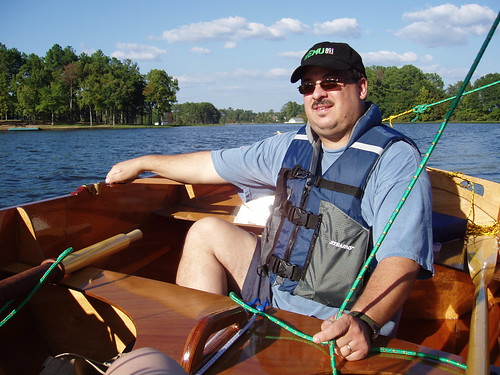After some prep work, including filling stitch holes and chine gaps with thicken ed epoxy, and a final overall sanding of the hull, the fiberglass could now be applied. A large bundle of 6 oz fiberglass cloth is supplied for this purpose. It is unfolded and draped over the hull, and the excess trimmed off to where only a small overhang remains beyond the edge of the sheerclamp. The loose weave of the cloth allows it to be arranged without wrinkles fairly easily. Then, in a technique detailed here, batches of unthickened epoxy were mixed and poured onto the flat surface of the hull. Using a rubber spatula, the epoxy is gently spread so as to wet down the cloth. The idea is to get the cloth just wet enough that it turns from white to clear, but so that some of the cloth texture remains after the epoxy is cured. This
ed epoxy, and a final overall sanding of the hull, the fiberglass could now be applied. A large bundle of 6 oz fiberglass cloth is supplied for this purpose. It is unfolded and draped over the hull, and the excess trimmed off to where only a small overhang remains beyond the edge of the sheerclamp. The loose weave of the cloth allows it to be arranged without wrinkles fairly easily. Then, in a technique detailed here, batches of unthickened epoxy were mixed and poured onto the flat surface of the hull. Using a rubber spatula, the epoxy is gently spread so as to wet down the cloth. The idea is to get the cloth just wet enough that it turns from white to clear, but so that some of the cloth texture remains after the epoxy is cured. This  allows the cloth to adhere to the wood of the hull, providing strength, durability, and waterproof-ness. Adding excess epoxy also adds weight, and runs the risk of "floating" the cloth out of close contact with the wood, reducing strength. It is a slow and painstaking task, but after a couple of hours, the hull was glass coated. Then, after a couple hours, when the epoxy was semi-cured, I trimmed the excess cloth from the bow, stern, and sheerline. Additional cloth tape will be applied to the bow and stern, and additional thin layers of epoxy will fill the weave of the cloth, leaving a smooth surface. Total hours 23.45.
allows the cloth to adhere to the wood of the hull, providing strength, durability, and waterproof-ness. Adding excess epoxy also adds weight, and runs the risk of "floating" the cloth out of close contact with the wood, reducing strength. It is a slow and painstaking task, but after a couple of hours, the hull was glass coated. Then, after a couple hours, when the epoxy was semi-cured, I trimmed the excess cloth from the bow, stern, and sheerline. Additional cloth tape will be applied to the bow and stern, and additional thin layers of epoxy will fill the weave of the cloth, leaving a smooth surface. Total hours 23.45.





No comments:
Post a Comment